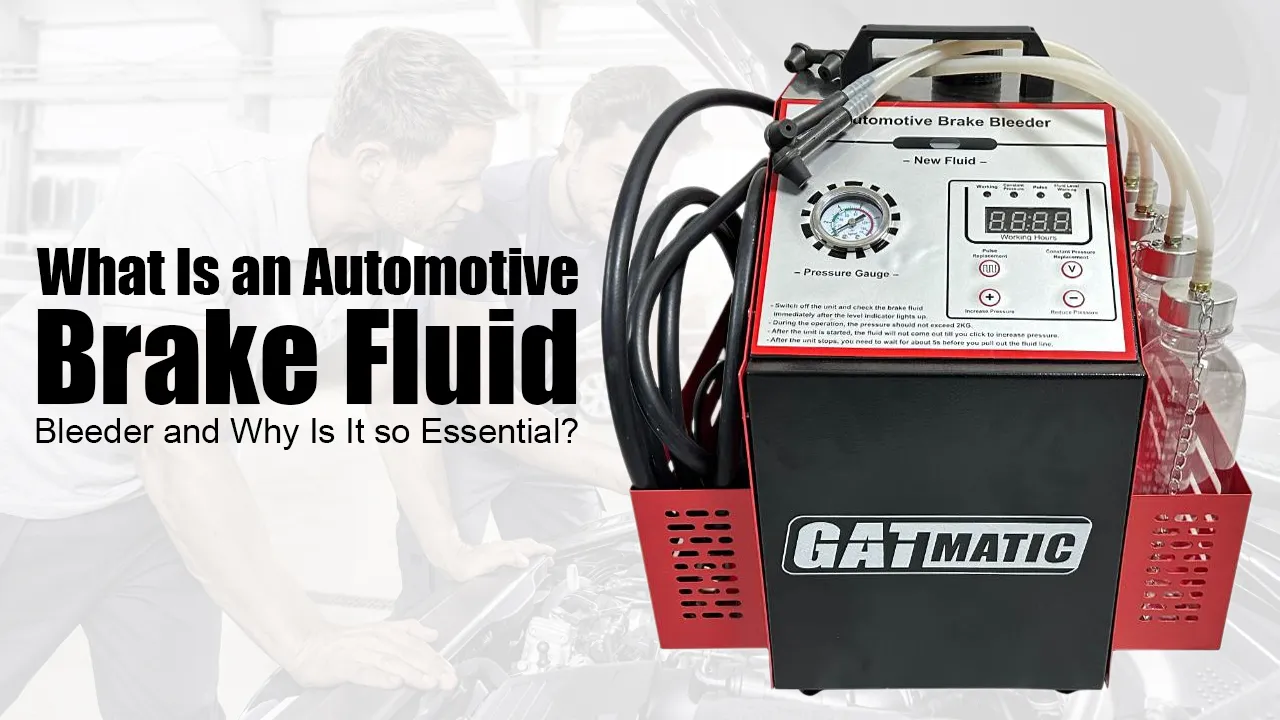Recent Blog
-
Why More Auto Repair Shops are adding Injector Cleaner and Tester in 2025
2025-07-29 -
Understanding the Key Features of an Automotive AC Recovery Machine
2025-07-24 -
GATmatic Shone Brightly at INA PAACE Automechanika Mexico 2025
2025-07-19 -
GATmatic Shows Industry-leading Products at INA PAACE Automechanika Mexico
2025-07-16
What Is an Automotive Brake Fluid Bleeder and Why Is It so Essential?
Introduction:
In the automotive industry, brake safety is vital. Even a small fault in the brake system can lead to serious consequences while driving. Therefore, brake system maintenance, especially brake fluid replacement, is a critical task for every repair shop. In order to complete this process effectively and safely, professionals use a tool called Automotive Brake Fluid Bleeder. In this blog, we’ll explain what the automotive brake fluid bleeder is, how it works, and why it’s an essential tool in any workshop.
What Is an Automotive Brake Fluid Bleeder?
An automotive brake bleeder is a specialized tool designed to quickly and efficiently replace old brake fluid in a vehicle’s hydraulic brake system. It works by applying controlled pressure to the brake fluid reservoir, pushing fresh brake fluid into the system while simultaneously forcing old, contaminated brake fluid out through the pressure relief valve. This process not only clears out old brake fluid, but also helps eliminate air bubbles in the brake lines, which is a major cause of spongy or unresponsive brakes.
Why Brake Fluid Replacement Matters?
That’s why regular brake fluid bleeding is not just a maintenance task — it’s a safety measure. Over time, brake fluid absorbs moisture and can become contaminated, leading to corrosion and reduced braking effectiveness. Regular fluid changes prevent these issues, ensuring the braking system’s longevity and reliability.
That’s why regular brake fluid bleeding is not just a maintenance task — it’s a safety measure. When you bleed the brakes, you are removing these contaminants from the system and replacing them with fresh, clean fluid. This will restore the brakes to their proper functioning condition.
Benefits of Using an Automotive Brake Fluid Bleeder
Efficiency and Speed
Compared to manual methods, an automotive brake bleeder dramatically speeds up the process. With pressure control and automated flow, technicians can complete a full brake fluid change in just a few minutes.
One-Person Operation
The traditional method requires two people to operate. However, with the use of the brake fluid bleeder, a single technician can independently complete the entire process, thus saving time and manpower.
Cleaner, Safer Work
By using sealed systems and connectors, the fluid bleeder reduces spills and harmful fluid exposure, protecting both the operator and the environment.
Precise Pressure Control
Most modern automotive brake fluid bleeders come with adjustable pressure regulators to match the requirements of different vehicles, ensuring a thorough and consistent bleed every time.
How Does an Automotive Brake Fluid Bleeder Work?
The basic working principle of a Brake Fluid Bleeder is to flush out old fluid while drawing in new fluid, without allowing air to enter the brake system. Here’s how it typically works:
- Connect the Bleeder to the Brake Fluid Reservoir:The bleeder tool is connected to the master cylinder or reservoir cap.
- Pressurize or Activate the System:The electric brake bleeders offer automatic, continuous pressure.
- Open the Bleeder Valves at Each Wheel:Starting from the wheel furthest from the master cylinder, technicians open bleeder screws to release old fluid and air bubbles.
- Refill with New Brake Fluid AutomaticallyThis system injects fresh fluid while pushing out the old fluid, and throughout the process, no air will be allowed to enter.
- Close Bleeder Valves and Check Pedal Feel:Once done, the brake pedal should feel firm, and the braking system fully restored.
Precautions When Using an Automotive Brake Fluid Bleeder
To ensure safe and effective operation of an Automotive Brake Fluid Bleeder, it’s important to follow these key steps and safety tips:
Initial Setup
Before starting the fluid replacement, power on the device, fill it with fresh brake fluid, and select either “Constant Pressure Mode” or “Pulse Mode”. Then press the “Increase Pressure” button to begin the operation.
Choose the Correct Replacement Mode
- Use Constant Pressure Modefor traditional vehicles, especially older models.
- Use Pulse Pressure Modefor modern vehicles where the brake master cylinder and ABS system are integrated, such as in many electric vehicles (EVs) and hybrids.
Final Step: Tighten Bleeder Screws in Correct Order
After completing the fluid exchange, always tighten the bleeder screws from the front wheels to the rear wheels. This ensures proper sealing and prevents air from re-entering the system.
Conclusion
An automotive brake bleeder is more than a convenient tool. It’s essential for maintaining peak brake performance, ensuring safety, and boosting workshop productivity. Whether you’re managing a busy service center or maintaining your personal vehicle, having a reliable brake fluid bleeder on hand is a smart investment. Contact us today for a demo or customized quote!
Describe Your Needs In Detail!
We will carefully evaluate your needs and give professional solutions.



